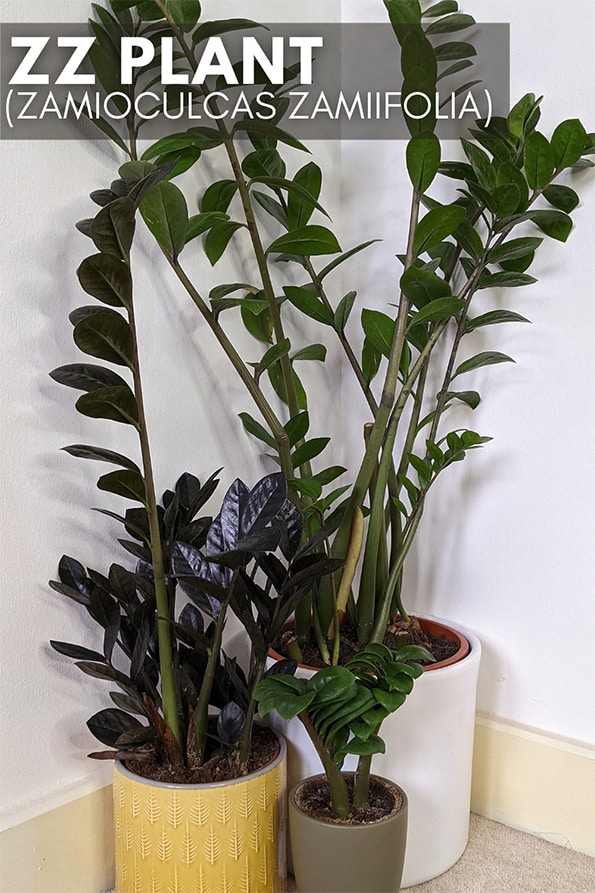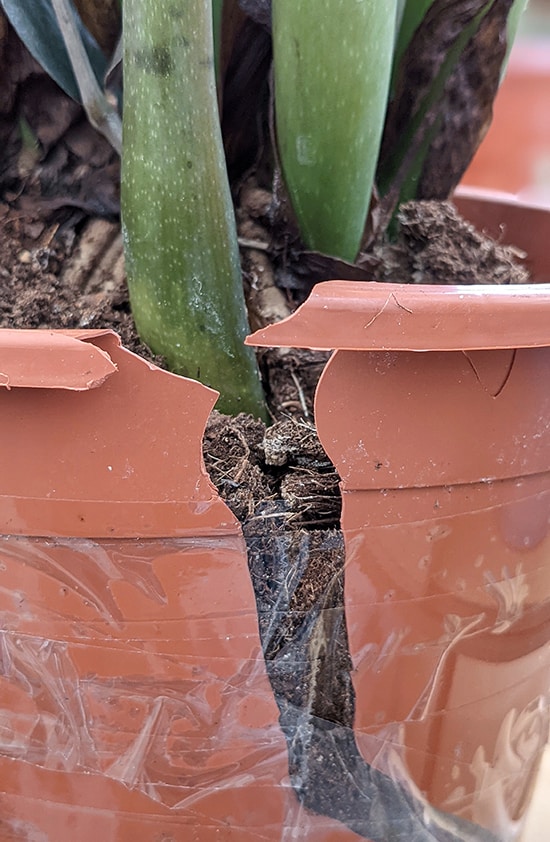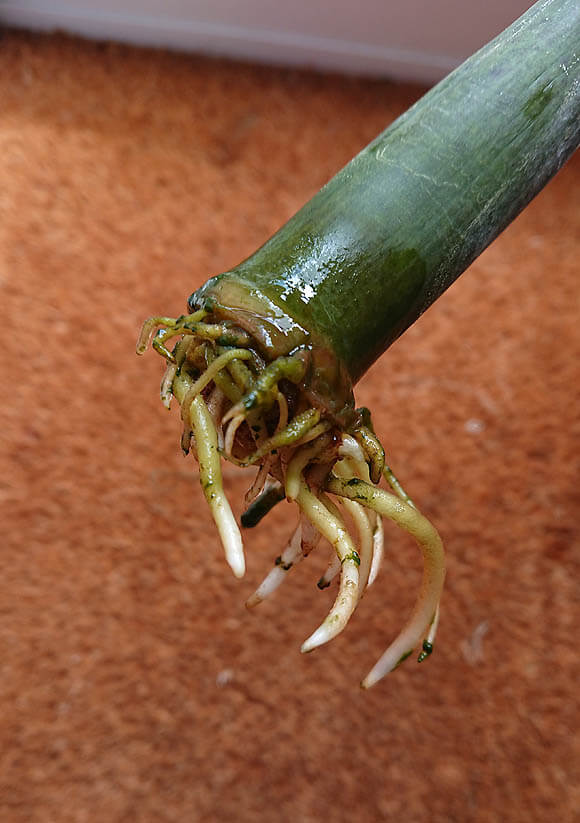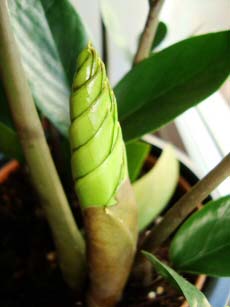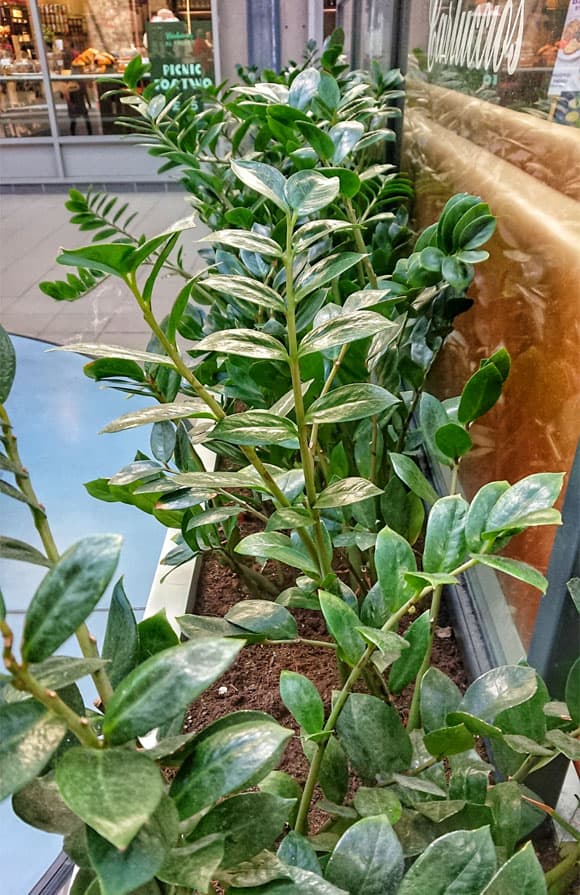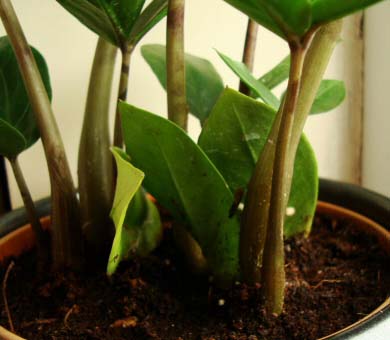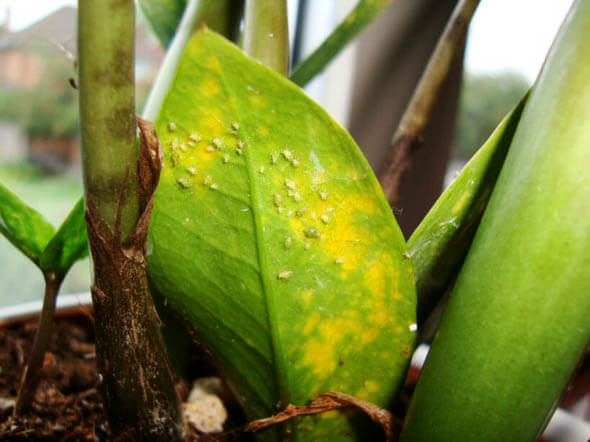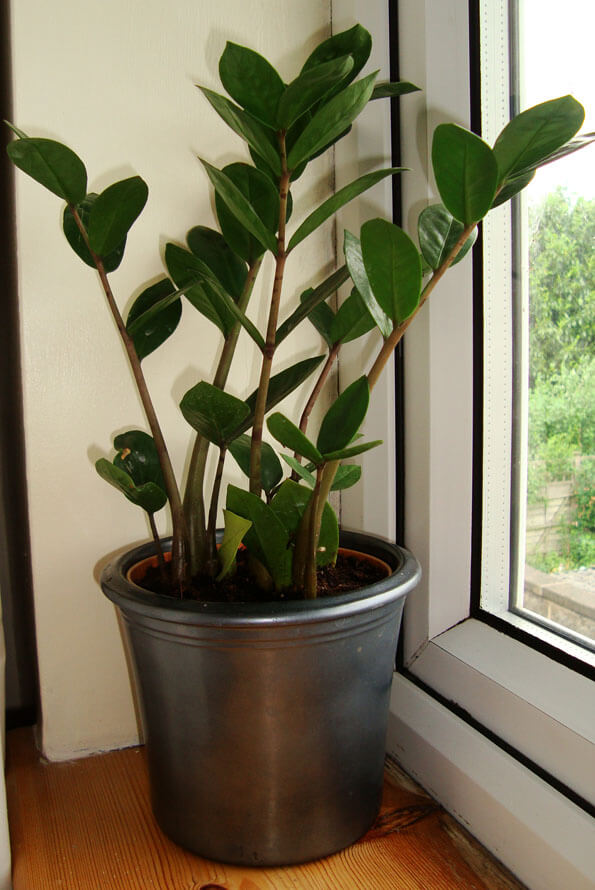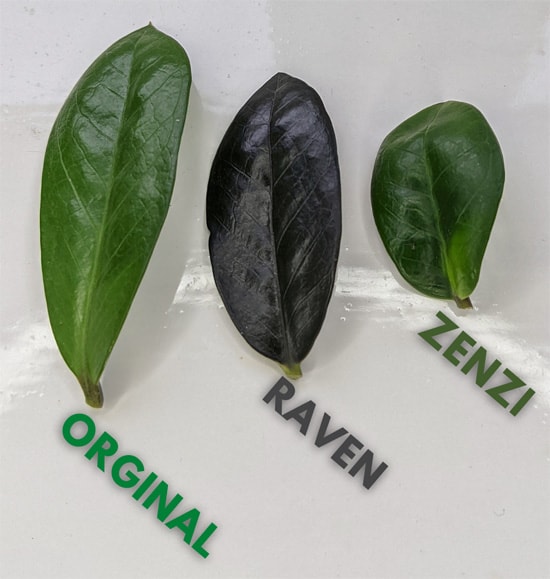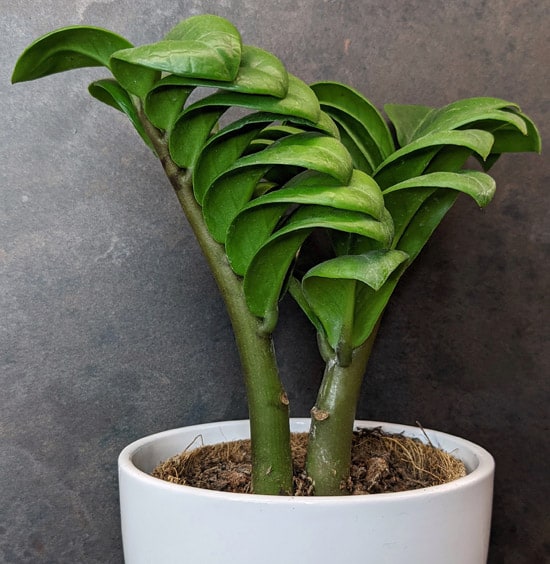Zamioculcas Zamiifolia or the ZZ Plant (say Zee Zee Plant) is a simple houseplant, ideal for both new and experienced plant parents alike.
It's a hardy plant that is easy to keep alive and will grow in various conditions making them ideal gifts for those with brown thumbs. They're also brilliant if you need an office plant that can put up with periods of drought and fluorescent lights.
Adaptable to many different light conditions, the ZZ Plant is currently a fashionable indoor plant and will fit within a contemporary or traditional home perfectly.
It has starchy potato-like rhizomes at the base of each stem and a textured look on the oval shaped glossy leaves that are arranged along its contrasting colored stem in a herringbone fashion.
It's a versatile and great looking plant with a lot going on to help it stand out.
Some of the ZZ Plant benefits are that it's stylish, attractive and easy to care for, with a straightforward propagation method. It can take a reasonable amount of neglect without adverse effects and is impervious to most pests.
Did you know? The ZZ Plant originates from Africa but has only started to be grown in mass by Dutch nurseries (where the majority of the western world's houseplants come from) in the late 1990's. It has gradually become more and more popular.
There are several
varieties to pick from today. I look at the main ones you can buy, at the end of this article if you want to learn more.
The main disadvantage of these plants is that they have an annoying tenancy not to do anything. At all. It doesn't grow; it doesn't get sick easily. It just sits there for long periods.
This lack of activity won't matter for some owners, but many keen gardeners and indoor plant owners like feedback from their plants. When things are right, they grow and flourish. When conditions aren't so good the plant lets you know about it through its sickly appearance and in that respect the ZZ Plant can be difficult to understand.
That said, it's still a versatile and great looking houseplant with a lot going on to help it stand out from the rest.

Hi, I'm Tom!
If you're like me and enjoy the challenge of growing houseplants and getting them to thrive, then Ourhouseplants can help. This website shares my knowledge and years of growing plants and provides (hopefully) helpful advice on properly caring for your indoor plant friends.
Your ZZ Plant will accommodate a broad spectrum of light conditions including low-light. However deep shade must be avoided if you want it to grow.
Equally too much light can be damaging as it doesn't like harsh direct sunlight found in South facing windows. Early morning or late afternoon sun is acceptable, therefore aim for a North, East or West facing window which gets good natural light.
You should take care here, the number one cause of plant issues is too much watering. So please read on to make sure you're doing it right.
This is a fairly drought-tolerant plant and can survive months without water, so infrequent watering and letting the soil dry out fully is no problem for your ZZ.
On the other hand, heavy constant watering without allowing the soil to dry out in between will turn the leaves yellow before rotting the tubers away. Drainage holes in the growing container is therefore recommended to help let the excess water drain away.
For productive and fast growth the soil needs to be just moist for the majority of the time between late Spring to early Autumn / Fall.
As a basic guide. In bright light and warm temperatures, aim for a heavy watering once a week. A gentle watering no more than once every two or three weeks in poor light conditions and over Winter. Adapt accordingly based on how the soil feels, if it's still damp when you come back a week later don't water again.
Not important for these plants. You can grow it any humidity range.
If your plant isn't growing, i.e. if it's in one of its "moods" (see introduction above and problem section below) or it's Winter, don't bother with fertilizer.
Even when it's growing, a weak feed once a month is more than adequate. I use a liquid all-purpose balanced fertilizer, because it gives you good control on how much you're providing.
This plant needs an average temperature between 13°C (55°F) and 26°C (79°F). Warmer temperatures in the upper range will give an increase in growth output.
Bulging Pots are not a problem - Each ZZ stem will normally grow several thick rhizomes around its base. These underground tubers can get quite big and can bulge and distort the container they're in. This isn't something to be worried about unless they split the container.
Only repot if it's needed and do it in Spring or Summer. This would normally be when you can see a lot of roots coming out of the bottom of the pot or if the pot is very badly shaped or has broken from rhizome growth.
A general all purpose potting mix is perfect. Avoid anything with heavy enrichment and you can also use a soil mix designed for succulents.
The roots and rhizomes that grow can be very strong and will split weaker planters in time. This makes them a perfect choice for a ceramic pot which should be able to hold things in.
ZZ Plant propagation is commonly done in one of two ways. The first is division which means you divide a mature plant once it's an enormous size and too big for its pot. This is the easiest way to propagate, because It's just a case of removing the entire plant from the existing container and gently separating some of the tuberous rhizomes.
Design Tip - The more you divide the parent plant, the smaller the new ones are going to be. So think carefully about this, as excessive division will affect the final appearance.
You could half the plant, split into thirds or divide even further if you have a very congested root system.
There are a few other less common ways to propagate ZZ Plants such as rooting stem cuttings in water. This is handy if you have an accident and an entire stem falls out of the plant and you would rather try and get it back in with the rest of the plant in the future instead of stripping it's leaves and trying to create multiple plants (see below).
Simply put the entire stem with all the leaves as they are, into a container or tall vase. After a few months, you should see roots forming at the base. Wait until the roots are reasonably substantial before either putting back into the pot with the original plant, or pot it up on it's own.
Be warned that this could take a very long time. When I did this myself I waited 9 months for enough roots to have formed before transferring from the water vase to soil.
It took a while - but there are now enough roots on this Zamioculcas Zamiifolia stem cutting to plant this up in potting soil.
If you don't want to lose the overall size and bulk or your plant isn't that large yet, it's also really easy to propagate more through leaf cuttings, which is the second commonly used method of propagation.
If you choose to propagate by leaf cuttings, then it will be a while before you'll see results. You could wait up to a year before anything substantial happens above ground. If you have the patience and love a challenge, give it a try.
If you choose to propagate by leaf cuttings then it will be a while before you'll see results. You could be waiting up to a year
All you need to do is gently pull off a leaf from the stem, allow the raw edge to dry slightly (few hours to a day) and then pot it up in a free draining compost mix with the raw edge going in first. Only a few centimeters of the leaf needs to actually be in the soil, just enough to hold it in place.
Most of the leaf needs to be above the ground which prevents rotting, and allows for photosynthesis to take place which in turn helps grow underground rhizomes. Keep warm and water very occasionally.
After you've done this one of three things will eventually happen:
If you want a visual guide for the leaf propagation method, I found a great video covering this on YouTube. You can watch it below.
YouTube Video showing a simple way to create more ZZ's through leaf cuttings
Slow to moderate and very sporadic. Warmer temperatures tend to result in more growth overall. When it's ready, the new stems emerge out of the soil at rapid speed and get taller before opening up, just like a cocoon.
Inside are all the new glossy light green leaves that will gradually emerge and fan out. The leaf color will darken to look like the rest of the established stems after a few months.
New shoot emerging that will unfurl and mature to show off many glossy dark green leaves.
The stems can grow to 60cm / 24. Its spread however is limited only by the size of the container it's in. Wide containers will produce a bushy plant as it spreads out (after many years).
ZZ Plants being grown grouped to create a natural plant screen.
The ZZ does grow flowers occasionally, but they're basic and not very exciting (see the photo gallery for pictures).
Due to the calcium oxalate crystals within the leaves and stems, all parts of a Zamioculcas Zamiifolia plant are mildly toxic to the majority of household pets including cats and dogs as well as people.
These crystals can also cause some skin irritation so keep the plant away from curious animals or kids.
The leaves are naturally glossy, so if they become dusty the leaves will lose their shine. Popping it into a tepid shower will help wash all the leaves quickly.
Don't use leaf shine products as this can be harmful and once washed, the natural gloss will come back.
Why isn't my ZZ Plant growing?
In most cases, the conditions you're providing could be perfect, but the plant is simply building and storing energy in the hidden tubers below the soil. Once enough energy has been created, a new stem with lots of leaves will burst out.
So little or no growth isn't really a problem but it's actually just the plants most annoying (but normal) trait. Some people have told us their plant hasn't grown at all since they brought it... 6 months ago!
The solution here is to just focus on three important variables, light, temperature and watering, forget everything else. Ensure the plant is put in a well lit location, not too dark, or too sunny.
Growth only tends to occur if the temperature is above 18°C / 64 °F. Finally the compost should be moist most of the time, rather than constantly bone dry or completely saturated.
Even when you get this balance spot on you might not see any change for months, so the final piece of the puzzle comes down to patience.
My Plant is too small
If you take a close look at our photo just below you can see three leaves sticking out of the soil. This is because when the plant was propagated, rather than just using one leaf a few were put quite close together to create several new plants all at once.
In general this plant is a slow grower, so this process speeds things up massively and helps make a wider and more pleasing plant to look at (although technically of course it's several all in one pot).
If you want to know how to propagate - read this. Initially the plant(s) may still be quite small, but in time they will get bushier and bigger.
Why are the leaves on my ZZ Plant turning yellow?
Unlike a lot of houseplants it's unusual for this one to drop its lower leaves as it ages. It does happen on occasion though, particularly as things get colder and Winter arrives, all of which will result in yellow leaves appearing.
However if the leaves are turning yellow very quickly and there is a lot of them changing color it's normally a symptom of overwatering. Although it's a hardy plant in general, it is sensitive to overwatering problems, so be careful. When in doubt it's better for the soil to be too dry rather than too wet.
Make sure the potting mix has an open quality to it and there is at least one drainage hole in the container. If there isn't you have to be extra careful not to let water accumulate around the roots and base of the planter.
Why are the stems on my ZZ Plant turning yellow?
Individual leaves are one thing, but an entire stem going yellow can be very worrying to witness. It could simply be an age issue again and therefore perfectly natural.
Alternately you're looking at an overwatering problem which has caused that area of the plant to rot. Try and remove the effected stem. If you find it's mushy at the base this is the cause.
Sudden leaf drop on ZZ Plant
Although unusual, this is usually a survival mechanism to drastic underwatering for prolonged periods. We're talking months here, not days or weeks.
The plant is naturally adapted to lack of water, but if it's been going on for a while, it will take more radical action by shedding leaves to reduce the rate of water loss through them.
If you're sure a drought hasn't or isn't taking place, then it's probably caused by overwatering and the tubers are quickly rotting away from too much water.
If root rot has set in then the affected parts of the plant are about to collapse into a mushy mess. Think about making replacements by propagating any healthy leaves that are still attached to the affected stem(s).
Uneven growth / Leggy and heavy stems
A tidy upright look isn't the ZZ's natural growth habit. They're normally sold like this because of how they've been grown at the start of their lives (strong overhead lights, with many plants close together). This encourages them to grow into the familiar upright form.
Once it's in your home a Zamioculcas plant will grow and lean towards light sources, making it seem untidy.
You can try and slow this from happening by rotating the pot every once in a while to encourage an evenly spread look, although some uneven growth is inevitable after a few years no matter what you do.
The best thing you can do is grab some canes and string and gently tie and shape your plant into the look you're after.
If light conditions are poor, the stems can become spindly, leggy or stretched and much longer than normal. It's harder to spot lean growth in the ZZ plant because the stems are so thick and long anyway. So look for the leaves becoming very spaced out and the stems top heavy instead. If you see this, consider moving to a brighter location.
There are Aphids on my plant
Aphids are annoying for any houseplant and the chances of getting them are increased greatly if you put them outside in the Summer. Unfortunately, if given an opportunity, Aphids love the chance to suck sap from the ZZ plant.
Aphid infestation on a ZZ Plant.
They can be a pain to get rid of and over time can spread viruses and diseases. The photo above shows an infestation along with the consequences - diseased leaves.
If your ZZ plant leaves ever show random yellow patterns including spots, or mosaic patterns (again see photo). Thoroughly check the plant for Aphids, they're well camouflaged so you may have to look closely.
If the plant is outside when you notice the problem then its possible natural predators such as Ladybirds will help you out and finish them off so you could leave things as they are. However this is unlikely if the plant is already indoors, or want to bring your plant insider for Winter.
You can either rub the Aphids off with your finger or mix up a spray with one part washing up liquid or liquid soap to about 19 parts water.
It only needs to be a weak solution for it to work, then spray. After a short time wash all the soapy water off the plant leaves. Remove disease infested leaves to stop it from spreading to the rest of your plant.
Back in the early 2000s, houseplants were mainly brought in physical shops and even then, the choice on offer was limited. You had all the usual suspects available but nothing really rare or special like you'll find today.
The plant in the photo here is quite small but they can grow quite big after a few years. You can expect several new green stems each year, that are bigger and longer than the existing ones. A few yellowing stems now and again, but otherwise it's a simple and easy houseplant.
The introduction of the ZZ Plant was one of the first to break the dull limited availability cycle that existed before.
For the first time in years here was a really interesting houseplant with a very exotic appearance and catchy sounding name. People liked them and they wanted more like it and sellers were all to happy to satisfy the demand. Today we have plants like String of Hearts and Haworthias available almost everywhere.
There's are four main varieties and cultivars. The most common is the original all green variety. Sometimes it goes by the name Zanzibar Gem, Eternity Plant or Emerald Palm. It's almost certainly going to be the ZZ you find in most average stores.
Leaves from the Original, 'Raven' and 'Zenzi' ZZ Plants.
The original one has larger leaves and will grow bigger and bigger stems as it matures and is truly the perfect all rounder. If you're new to houseplants or the ZZ in general, start with this one and you won't go far wrong.
The original can fan out quite a bit and take up space. If you like the look, but have limited room, search out the "Zamicro' cultivar. The same look, but has a dwarf like quality and so doesn't get overly tall.
Zamioculcas Zamiifolia 'Raven' or the 'Raven' ZZ Plant is the second type of ZZ to appear on the market and it made a huge splash when it started to be sold a few years ago.
This one has very dark maroon leaves, which in a certain light look almost black. I've found it grows a little slower and certainly is more compact than the standard ZZ, but overall it's still an easy care plant. The leaves will start out a lighter green, but will darken up after a few months.
It was challenging to find when it was first released and quickly became a "rare houseplant" that commanded a high selling price. I've found it to be much cheaper these days and only a fraction more expensive than its more common cousin and it's sold in many more stores.
ZZ Raven might be hard to find, but it could be worth it if the dark foliage appeals to you.
The 'Zenzi' ZZ is new to the market. The first time I saw it for sale in a store was at the end of 2021. It wasn't expensive considering what the 'Raven' started out at, but this makes sense to me because the plant has a very dwarf growing habit and is pretty small.
Growers need far less space to cultivate these plants and their dainty size means they cost much less to ship. If they prove popular, I would expect them to be more commonly seen within a few years.
The leaves which grow on very thick stems are slightly curved and grow tightly together, so much so there is only a really slim gap between each leaf. These are slow growing and their overall footprint makes them ideal "small space" fillers.
The 'Zenzi' ZZ has tightly packed leaves that grow on thick stems
The name gives it away, but the fourth variety is variegated. It's very hard to find currently and online sellers charge quite a bit. I don't have one in my collection just yet so no photos, but you can see some here.
I think they look really unusual and sometimes quite beautiful. But I want to pick mine in person (or from an online seller with detailed pictures), as some of this yellowing and variegation doesn't appeal to me at all.
I've also read reports about the Chameleon ZZ Plant reverting (new shoots come up completely green), so I'm happy to wait a little while to see what happens before adding one to my collection. If you've got one though, or some experience with ownership get in touch. I would love to hear from you.
(Gallery) Photo credit of the ZZ in the home study Min An
(Gallery) Photo credit of the ZZ on a wooden floor to Andreas Hammerschmidt
